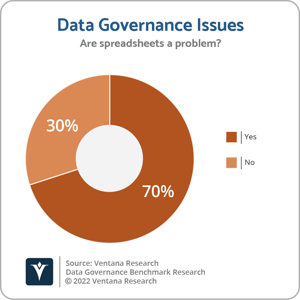For far too long, business intelligence technologies have left the rest of the exercise to the reader. Many of these tools do an excellent job providing information in an interactive way that lets organizations dive into the data and learn a lot about what has happened across all aspects of the business. More recently, many of these tools have added augmented intelligence capabilities that help explain why things happened. But rarely did any of these tools provide information about what to do or how to evaluate the alternative ways in which you might respond.
Perhaps this is one reason spreadsheets continue to be used so widely. Our research shows that 75% of organizations are still using spreadsheets for data and analytics processes even though 70% acknowledge that they pose a data governance issue.
though 70% acknowledge that they pose a data governance issue.
Some vendors are starting to talk about “decision intelligence” as an approach to address this gap. What’s involved in making an intelligent decision? And what’s required for this emerging category?
Organizations still need to analyze past results in order to understand what happened. Further analysis is typically required to understand why things happened. Sometimes, the analysis of why things happened requires data science or descriptive analytics to tease out relationships in the data that might not be obvious from reports and dashboards.
When examining what happened, it’s also important to understand what an organization wanted to happen – in other words, what were the plans and targets? How do the actual results vary from the goals? While you can review plans and targets in reports and dashboards, they are typically set using planning tools. And I will repeat what I have written before, you can’t plan using only artificial intelligence and machine learning. AI and ML are useful for descriptive, predictive and prescriptive analytics, but not for driver-based planning. For example, when using predictive analytics to target the best prospects with the best offers via the best channels, an organization might design a marketing campaign that results in orders for 100,000 widgets. However, the organization must use planning software to determine what raw materials are needed, how much staffing is required and how long it will take to produce those widgets. My colleague Rob Kugel has written about the importance of planning software and how AI/ML can be used in conjunction with these applications to create more accurate plans.
Another role of planning software is to evaluate alternative scenarios. If an organization is seeking to increase sales via additional advertising, planning software projects the cost and revenue implications of different scenarios. Once these scenarios are prepared, a decision can be made between different options.
This is where decision intelligence comes in. To make an intelligent decision, an organization must be able to compare the implications, likelihood and risks of different scenarios. The implications come directly from driver-based plans. The likelihood and risks come from predictive analytics, often using AI/ML. Further, an organization typically faces constraints in available resources. These constraints force trade-offs between competing demands for resources. Optimization software helps evaluate the best use of those resources.
Decision intelligence should include historical business intelligence; driver-based planning; AI/ML-based descriptive, predictive and prescriptive analysis; and optimization capabilities. All of this input is necessary to make effective decisions. As the decision intelligence market continues to evolve, keep these processes in mind. Learn how your organization might take advantage of these capabilities to make more informed decisions that improve operations.
Regards,
David Menninger


 though 70% acknowledge that they pose a data governance issue.
though 70% acknowledge that they pose a data governance issue.








